Wed 21 Apr 2021
An Archived Book! Movie!! Review by Dan Stumpf: ERIC AMBLER Journey Into Fear // Films (1942/1975).
Posted by Steve under Reviews , Suspense & espionage films[13] Comments
ERIC AMBLER – Journey Into Fear. Hodder & Stoughton, UK, hardcover, 1940. Alfred A. Knopf, US, hardcover, 1940. Reprinted many times, in both hardcover and paperback.
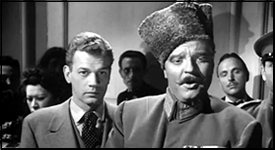
â— JOURNEY INTO FEAR. RKO Radio Pictures, 1943. Joseph Cotten, Dolores Del Rio, Ruth Warrick, Agnes Moorehead, Jack Durant, Everett Sloane, Orson Welles. Screenplay by Orson Welles & Joseph Cotten, based on the novel by Eric Ambler. Directed by Norman Foster & Orson Welles (the latter uncredited).
â— JOURNEY INTO FEAR. New World, 1975. Sam Waterston, Zero Mostel, Yvette Mimieux, Scott Marlowe, Ian McShane, Joseph Wiseman, Shelley Winters, Stanley Holloway, Donald Pleasence, Vincent Price. Screenplay: Trevor Wallace. Director: Daniel Mann.
A local video store was going out of business lately, and naturally I stopped by to see what priceless treasures I could pick up on the cheap. Among the things I emerged with was the remake of Journey Into Fear, adapted by producer Trevor Wallace from Eric Ambler’s 1940 novel (previously filmed by Orson Welles in 1942) and directed by Daniel Mann. Watching this, I began to suspect that Wallace’s script drew rather more from the 1942 film than from Ambler’s novel, so I pulled out the older film and the book to check my suspicions.
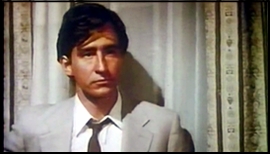
The 1942 film is an engagingly gimmicky piece, complete with the Mercury players (Agnes Moorhead, Everett Sloan et al.), but the effect is somewhat vitiated by Welles’ giving himself all the smart lines and by his decision to depict the quiet Graham (Joseph Cotton) as a boob.
The overall theme is deliberately un-heroic, which is probably just as well, given his strong visual style; a Welles movie with an out-and-out Hero would come off as altogether too Wagnerian. There is, in fact, more than a touch of Wagner in Welles’ two most nearly heroic characters, Rochester in Jane Eyre and MacBeth. But there I go digressin’ again
To be fair, there are a couple lines from the novel in the newer film and not in the 1942 version. But to be frank, huge chunks of Welles’ film seem to have been simply re-shot without credit and plunked down in this movie. When Orson Welles and Joseph Cotton adapted Ambler’s novel for the film (Cotton gets sole screen credit for the writing) they gave lines from one character to another, re-arranged scenes and added little bits of business, and all these changes appear just about shot-for-shot in the re-make.
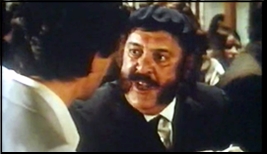
In fact, the earlier film features a hired killer who never speaks, because the guy who played him was no actor and would only do the part if they cut out all his lines. And sure enough, in the re-make the hired killer – played by the very capable actor Ian McShane — has no dialogue.
What difference exists between the two films is largely in the ordinary look of the ’74 film — the careful camerawork and set design of the original replaced by harsh color and tinny sound — and in the casting: Welles filled his film with capable bit players whose names mean little to most moviegoers, but players who leave a distinctive impression – the best-known are maybe Everett Sloane and Hans Conreid.
The re-make, on the other hand, is filled with second-rank “stars” mostly miscast or wasted: Sam Waterston is fine in the lead, and Vincent Price and Donald Pleasance have a couple good scenes (though Price makes a decidedly unconvincing Arab) but Zero Mostel, Shelley Winters, Scott Marlowe, Yvette Mimieux and even Stanley Holloway all just kind of take up space.
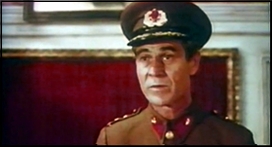
On the plus side, though, I’ve got to say Joseph Wiseman (fondly remembered as the first of the Bond villains and star of his own comic-book cover) is fine in the old Orson Welles part as Colonel Haki, there’s a solid, actionful ending, and a shoot-and-chase done entirely with sound effects. I still can’t figure out whether it was meant to be clever or merely cheap, but it’s enough to elevate this startlingly unoriginal film into the class of a pleasant time-filler.
Moving on just briefly to Eric Ambler’s novel (the excuse for this piece, after all) well, it was one of those things I read in 7th grade, and I was glad to come back to it. Even after seeing two movies and getting very familiar with the plot, I found the writing absorbing and the story suspenseful.
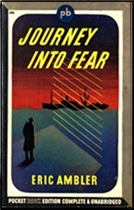
Ambler’s tale takes a bit of familiarity with the political map of war-torn Europe in the 40s; readers who didn’t live through it or bone up on their History might wonder at a story where British and German agents travel freely in Turkey while the British are supposedly arming the Turks against Hitler, but complications like this were pretty much gratis when Ambler wrote it, and by the time he gets to the crux of the tale — Howard Graham, an un-assuming British engineer trapped on a tramp steamer with a bizarre assortment of passengers, one of whom wants to kill him — he has notched the suspense up very agreeably indeed, and proceeds to a conclusion that is both cynical and exciting: no small feat, that.
Ambler also does a sharp job here creating an atmosphere of claustrophobic tension, and he adds a layer of genuine thoughtfulness: our hero starts out his journey as a man with secrets to hide, and he seems at first rather unique and isolated, surrounded by a ship full of very ordinary and rather dull background characters.
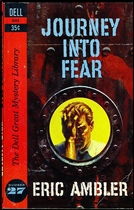
As the book and the journey go on, though, we discover the rest of the cast have their own secrets: droll, noble, sinister or just venal, the passengers who began the journey as stereotypes become real by the story’s end, and the central character seems much less unique — and more believable.
This works both as a plot device (I won’t say how) and as something more. Perhaps Ambler, writing in a world at war, was trying to say something about the worth of the Individual. Or maybe he was just setting us up for a delicious bit of anticlimax at the very end of the book, when the last secret is revealed.
Whatever, it makes for the kind of reading one remembers.
April 21st, 2021 at 7:26 pm
Colonel Haki is one of four series characters in Ambler’s novel length fiction including a Boris, Russian spy, writer Charles Latimer, and Arthur Abdul Simpson (the only one of the four to be a main character in more than one book), and I much prefer Welles colorful interpretation of the character (which is closer to both this novel and COFFIN FOR DIMITRIOS).
The non performance in the original film by the actor playing the villain is one of the great uses of stunt casting, direction, and camera work ever. Quiet, bland, vaguely inept he seemed to represent everything we think of in an Ambler novel, his menace all the greater because he is such a nonentity, and the finale one of the great endings to a spy film.
Like the remake of THE LADY VANISHES from this same general period my impression then and now is simply why bother to remake perfection if you can’t come anywhere near the original in cast, direction, and atmosphere?
April 21st, 2021 at 7:53 pm
There lots of answers to that question, of course, and some are better than others. I wonder how many remakes end up better better and/or more successful than the originals? To keep this results impartially honest, I suggest that you and I be the judges.
In any case, if the question is, who could play Haki better than Orson Welles, the answer is nobody.
April 21st, 2021 at 11:24 pm
Colonel Haki has such a presence in the books that even his non-appearance in Light of the Day casts a long shadow.
Haven’t watched the movies so can’t say but agree with you totally about the book.
April 22nd, 2021 at 8:19 am
Neither movie seems to be available online, which is a pity, especially since I was totally unaware of the existence of the one from 1975 until now. I did find an introduction to the Welles film that Eddie Muller did for TCM w while back, and here it is:
April 22nd, 2021 at 8:23 am
I cannot even find a commercial release on DVD for either film.
April 22nd, 2021 at 2:52 pm
I recall watching it years ago via VHS. I’d love to see it come out on DVD.
April 22nd, 2021 at 3:08 pm
Keeping in mind that this is hearsay only, I have read that the Welles film is in the public domain and many non-commercial bootleg versions exist. It is also said that the version that is generally available has been chopped up, with many scenes missing. If true, this is a very unsatisfactory state of affairs. (The Eddie Muller intro suggests it has been shown on TCM.)
April 22nd, 2021 at 7:29 pm
The first film has been available at various times to watch on YouTube, and I believe is on Classic Reels currently.
I don’t object to remakes per se. THE MALTESE FALCON is a remake after all (third remake at that), and I have some affection for the 2005 KING KONG, and the Kenneth More scene for scene remake of THE THIRTY NINE STEPS. I preferred COLORADO TERRITORY to HIGH SIERRA and BADLANDERS was a quite good remake of ASPHALT JUNGLE as a Western.
On the other hand I can think of dozens of films only an idiot would remake (and one did PSYCHO). Remakes of SEVEN DAYS IN MAY, THE MANCHURIAN CANDIDATE, STAGECOACH, THE WOMEN, and AND THEN THERE WERE NONE pretty much fit the pattern.
I don’t hold the same opinion of most plays since most were designed to be interpreted by others in multiple incarnations unlike most movies.
April 22nd, 2021 at 7:42 pm
An interesting observation that I hadn’t thought about before.
April 22nd, 2021 at 8:03 pm
I am the only known film historian who liked the remake of PSYCHO.
Watching its color design is fascinating, IMHO.
April 23rd, 2021 at 6:12 pm
Hi how are you all? Me tired shoveling some snow,thank God that the apocalypse is over here in the Province of New Brunswick Canada is a town of Edmundston, last week it was summer, but this week winter just like January. Journey Into Fear 1943 is available at Archive.org, here is the link
https://archive.org/details/1943-journey-into-fear-estambul-norman-foster
At Archive,org, there are a lot of movies and the Person here who said that the Orson Welles movies were in Public Domain was right, because at Archive.org, They do not have movies with copyright. Thanks and take care and be safe and God Bless.
April 23rd, 2021 at 7:43 pm
Aha! Thank you, Serge. It’s a little fuzzy on my screen, but there it is. I think I’ll watch it again tonight.
April 30th, 2021 at 8:52 pm
Earlier, I didn’t feel I had any comment to submit which could compare to the giant stature of this book and film combo. But I’ve thought of something to remark on. It’s this:
I like the way the world mostly stayed the same between the 1940s version and the 1970s version. That is a deft bit of writing finesse. No Nazis in the ’70s. So, how did they pull it off? I’ve seen both movies, but I don’t recall. I know I enjoyed both.
Turkey is still the same Turkey in both films; and in real life Istanbul certainly is the same. So that part was easy. That city is one which never changes; thus my admiration. There’s still hardly a single ‘skyscraper’, I doubt the few it possesses are taller than forty floors. Prayer calls still sound five times per day and there are still Turkish baths and coffeeshops and other simple, rustic pleasures.
Cargo ships also remain stable since intermodal containerization took place. That was the big change in that industry. Another thing I’m a fan of, though. Working ships!
Admittedly, wartime ‘stick ships’ are more romantic. In any case, Ambler’s choice to set this tale on a freighter marks it (for that alone) as a fave of mine. Similarly, Huston’s ‘Beat the Devil’. Gad I love that flick.